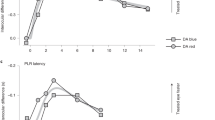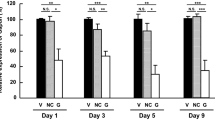Abstract
We have investigated whether antisense oligonucleotides delivered intravitreally could reduce gene expression specifically in the retina. In this study, phosphorothioate antisense oligonucleotides targeted to fibronectin transcripts were coupled to a novel carrier and used to specifically reduce fibronectin (FN) expression in retinal vascular cells. Using confocal microscopy, fluorescence from fluorescein isothiocyanate-labeled FN-oligonucleotides was detected in retinal vascular cells at 24 h postinjection and persisted until day 6 (the end point of this study). The fibronectin mRNA level was consistently decreased to 86.7% ± 7.9% of control (p<0.05) at day 2, and 46.7% ± 4.9% of control (p<0.01) at day 6. In contrast, the β-actin mRNA level, an internal control, was unaltered in rat retinas that received FN-oligonucleotides. Fibronectin protein level at day 6 was also significantly reduced to 61.4% ± 16% of control (p<0.01). No toxic effect resulting from the carrier was detected histologically. Thus, intravitreal delivery of antisense oligonucleotides to modulate abnormal gene expression in retinal diseases may be an effective approach for ocular gene therapy.
This is a preview of subscription content, access via your institution
Access options
Subscribe to this journal
Receive 12 print issues and online access
$209.00 per year
only $17.42 per issue
Buy this article
- Purchase on Springer Link
- Instant access to full article PDF
Prices may be subject to local taxes which are calculated during checkout



Similar content being viewed by others
References
Osterby, R. in In Diabetes Mellitus. Theory and Practice (ed. Rifkin, H. and Porte, D.) 220–233 (Elsevier Science, New York, 1990).
Roy, S., Sala, R., Cagliero, E. & Lorenzi, M. Overexpression of fibronectin induced by diabetes or high glucose: a phenomenon with a memory. Proc. Natl. Acad. Sci. USA 87, 404– 408 (1990).
Roy, S., Cagliero, E. & Lorenzi, M. Fibronectin overexpression in retinal microvessels of diabetic patients. Invest. Ophthalmol. & Visual Sci. 37, 258–266 (1996).
Roy, S. & Lorenzi, M. Early biosynthetic changes in the diabetic-like retinopathy of galactose-fed rats. Diabetologia 39, 735–738 (1996).
Roy, S., Maiello, M. & Lorenzi, M. Increased expression of basement membrane collagen in human diabetic retinopathy. J. Clin. Invest. 93, 438–442 (1994).
Cagliero, E., Roth, T., Roy, S. & Lorenzi, M. Characteristics and mechanisms of high-glucose-induced overexpression of basement membrane components in cultured human endothelial cells. Diabetes 40, 102–110 (1991).
Roy, S. & Roth, T. Proliferative effect of high glucose is modulated by antisense oligonucleotides against fibronectin. Diabetologia 40, 1011–1017 (1997).
Sanna, P., Jirikowski, G., Lewandowski, G. & Bloom, F. Applications of DAPI cytochemistry to neurobiology. Biotech. & Histochem. 67, 346–350 (1992).
Kabanov, A.V., Vinogradov, S.V., Suzdaltseva, Y.G. & Alakhov, V.Y. Water-soluble block polycations as carriers for oligonucleotide delivery. Bioconjugate Chem. 6, 2– 6 (1995).
Mundigl, O., Ochoa, G.C., Slepnev, V.I., Kabanov, A.V. & DeCamilli, P. The role of amphiphysin in neurite outgrowth. J. Neuroscience 18, 93– 103 (1998).
Hangai, M., Kaneda, Y., Tanihara, H. & Honda, Y. In vivo gene transfer into the retina mediated by a novel liposome system. Invest. Ophthalmol. & Visual Sci. 37, 2678–2685 (1996).
Robinson, G.S. et al. Oligodeoxynucleotides inhibit retinal neovascularization in a murine model of proliferative retinopathy. Proc. Natl. Acad. Sci. USA 93, 4851–4856 (1996).
Essner, E. & Lin, W.L. Immunocytochemical localization of laminin, type IV collagen and fibronectin in rat retinal vessels. Exp. Eye. Res. 47, 317–327 (1988).
Mandarino, L.J., Sundarraj, N., Finlayson, J. & Hassell, J.R. Regulation of fibronectin and laminin synthesis by retinal capillary endothelial cells and pericytes in vitro. Exp. Eye. Res. 57, 609–621 (1993).
Kabanov, A.V. & Kabanov, V.A. DNA complexes with polycations for the delivery of genetic material into cells [Review]. Bioconjugate Chem. 6, 7–20 (1995).
Fitzgerald, M.E. & Caldwell, R.B. The retinal microvasculature of spontaneously diabetic BB rats: structural and luminal surface properties. Microvasc. Res. 39, 15–27 (1990).
Magnuson, V. et al. Alternative splicing of fibronectin pre-mRNA in rats is altered during aging and in response to growth factors. J. Biol. Chem. 266, 14654–14662 (1991).
Colvin, R.B. in Fibronectin (ed. Mosher, D.) 213–254 (Academic, Harcourt Brace Jovanovich, San Diego, 1989).
ffrench-Constant, C., Van De Water, L., Dvorak, H.F. & Hynes, R.O. Reappearance of an embryonic pattern of fibronectin splicing during wound healing in the adult rat. J. Cell. Biol. 109, 903–914 (1989).
Vinogradov, S.V., Bronich, T.K. & Kabanov, A.V. Self-assembly of polyamine-polyethyleneglycol copolymers with phosphorothioate oligonucleotides. Bioconjugate Chem. 9, 805–812 (1998).
Chirgwin, J.M., Przybyla, A.E., MacDonald, R.J. & Rutter, W.J. Isolation of biologically active ribonucleic acid from sources enriched in ribonuclease. Biochemistry 18, 5294– 5299 (1979).
Scwarzbauer, J.E., Patel, R.S., Fonda, D. & Hynes, R.O. Multiple sites of alternative splicing of the rat fibronectin gene transcript. EMBO J. 6, 2573–2580 (1987).
Roth, T., Podesta, F., Stepp, M.A., Boeri, D. & Lorenzi, M. Integrin overexpression induced by high glucose and by human diabetes: potential pathway to cell dysfunction in diabetic microangiopathy. Proc. Natl. Acad. Sci. USA 90, 9640– 9644 (1993).
Acknowledgements
This work was supported by a Research Award from the American Diabetes Association and the National Eye Institute, NIH (EY11990-01A1). The work of the group at the University of Nebraska Medical Center was supported by a grant from the National Science Foundation (BES-9712657).
Author information
Authors and Affiliations
Corresponding author
Rights and permissions
About this article
Cite this article
Roy, S., Zhang, K., Roth, T. et al. Reduction of fibronectin expression by intravitreal administration of antisense oligonucleotides. Nat Biotechnol 17, 476–479 (1999). https://doi.org/10.1038/8654
Received:
Accepted:
Issue Date:
DOI: https://doi.org/10.1038/8654
This article is cited by
-
Drug Delivery Using Nanocarriers: Indian Perspective
Proceedings of the National Academy of Sciences, India Section B: Biological Sciences (2012)
-
Recent Perspectives in Ocular Drug Delivery
Pharmaceutical Research (2009)
-
Novel Nanomaterials for Clinical Neuroscience
Journal of Neuroimmune Pharmacology (2008)
-
Evaluation of polyether-polyethyleneimine graft copolymers as gene transfer agents
Gene Therapy (2000)



